 |
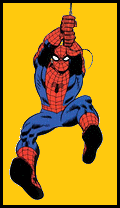 |
|
 SPOTLIGHT
ON
SPOTLIGHT
ON
SPIDER-MAN,
DOCTOR STRANGE & THOR
INSIDE
A
JUNE
1978 MARVEL MULTI-MAGS
|
|
|
|
| |
AMAZING
SPIDER-MAN #181
DOCTOR STRANGE #29
MIGHTY THOR #272
|
|
 |
|
| |
|
| |

By the mid-1970s,
Marvel Comics had
fully embraced the marketing concept of selling
multiple comic books packaged in a sealed plastic
bag to a customer base which comic books could
hardly reach otherwise, i.e. in supermarkets and
department store chains.
This
example of a
MARVEL MULTI-MAGS features three
titles from the June 1978 cover date run (meaning
they were actually on sale in March 1978): Amazing
Spider-Man #181, Doctor
Strange #29 (the
"hidden" comic book in the middle of
the pack), and Mighty Thor #272.
Both Spider-Man and Thor could be found regularly
in MARVEL
MULTI-MAGS of the mid to late 1970s;
the presence of an issue of Doctor Strange,
however, is a rarity.
Selling for
99¢, this comicpack came with
a small bargain compared to the newsagent total
of $1.05 for the same three comic books (earlier
in the 1970s comicpacks only sold for
1¢
less than the total of the cover prices);
however, sales tax at the department store
checkout would gobble up most if not all of that
saving.
There is no general rule as
to what shape/grade the comic books in a
MARVEL MULTI-MAGS (or
any other comic pack for that matter) will be in.
During their 40+ years of storage, a lot of
things can go wrong. Some of these will only
affect the plastic bag, while others might not
harm the packaging as much as the contents.
As a result, almost any
combination is possible: you can have a polybag
displaying lots of wear but perfect comic books
inside (meaning it was mostly stored in a dark
and cool place but at some time took some outside
soiling or slight mechanical abrasion), but you
can just as well have a near pristine polybag
holding comic books showing substantial paper
degradation (indicating the bag was stored with
care but exposed to light and excessive warmth
for an extended period of time).
The polybag
of this June 1978
MARVEL MULTI-MAGS is very clean in
comparison to some packagings of the same period
and also shows no discernible wear. The same
holds true for the three comic books inside which
proved to be in excellent overall condition:
pristine
covers with perfect gloss and shine, perfectly
flat and tight (without any spine stress), with
no creases and sharp edges, and white to
off-white pages throughout all of the books.

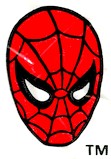
|
|
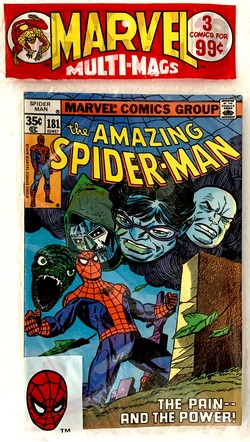
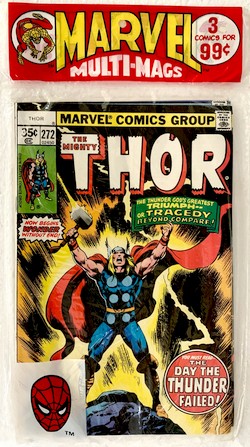
|
|
| |
| Compared to the
comic book three-packs put out by
DC in the 1970s,
MARVEL MULTI-MAGS
- not unlike the superheroes
they featured - had a distinct flaw. The continuity of
the Marvel Universe of the 1970s was such that storylines
usually evolved over more than one issue, so that having
one single issue of a title would possibly provide for an
entertaining read but also most likely end on a
cliffhanger - to be resolved in the next issue. No titles
had permanent slots in the
MARVEL MULTI-MAGS, however, so missing out on
the continuation of a storyline was a possibility with
some titles (e.g. Amazing Spider-Man and Mighty
Thor) and all but certain with others (e.g. Doctor
Strange). However, one needs to also bear in
mind that this was a common fate of the average comic
book reader in the 1970s, whether his or her comic books
came packaged in a plastic bag or as single issues from a
display or spinner rack.
|
| |
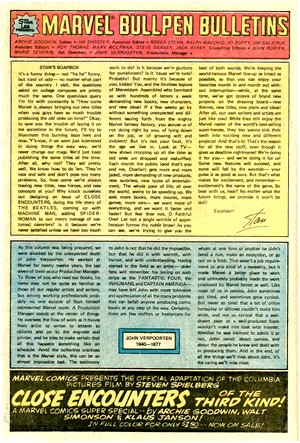
|
|
In those days, an
uninterrupted supply of specific titles
simply was not guaranteed, and one
quickly became quite adept at not feeling
too worried over possible gaps in
storylines. Besides, you would usually
get a recap of what had happened so far
on the first page. It simply was all a
part of being a comic book fan in the
1970s - just as Marvel's monthly Bullpen
Bulletins and in-house advertising were.
In this
case, Stan Lee was casually plugging a
few new titles and characters (and
name-dropping the fact that he got
invited to college campuses) while
adressing the question (if it actually
was one) why Marvel kept putting out new
titles and characters. It's the wonderful
mix of deliberately open
self-advertising, mock self-criticism ("How
come Marvel is always bringing out new
titles when you guys have so much trouble
producing the old ones on time?")
and avuncular self-humoring ("But
fear thee not, O Faithful One! Let not a
single wrinkle of apprehension furrow thy
noble brow!") - all of which
adds up to the famous Marvel House Style.
Readers
were also informed of the sudden and
unexpected death of John Verpoorten at
the age of 37. Originally working as an
inker for Marvel, Verpoorten became their
production manager in 1970, and some say
that this high-stress job contributed to
his early passing.
And,
finally, the still growing popularity of
Sci-Fi in 1978 was mirrored by Marvel's
official adaptation of Steven Spielberg's
Close Encounters of the Third Kind as
a "Super Special".
|
|
|
| |
| Also of note, by
the way, is the Bullpen Bulletin title, which lists a
whole slew of creative talent in various production and
editorial functions - such as Jack Kirby having the role
of consulting editor. |
| |
|
| |
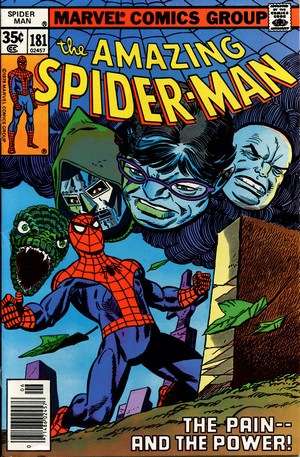
|
|
AMAZING
SPIDER-MAN #181
June 1978
(monthly)
On Sale: 14 March 1978
Editor -
Marv Wolfman
Cover - Gil Kane & John Romita
(pencils), Mike Esposito (inks)
"Flashback!" (17 pages)
Story - Bill Mantlo
Pencils - Sal Buscema (breakdowns), Mike
Esposito (finished art)
Inks - Mike Esposito
Lettering - Annette Kawecki
Colouring -
Glynis Wein
Synopsis
!
SPOILER ALERT !
Visiting the
grave of his Uncle Ben, Spider-Man thinks
back and reflects on his entire career as
Spider-Man. He recalls the events that
gave him his spider-powers and how the
death of his Uncle Ben acted as the
catalyst for him to actually become
Spider-Man.
|
|
|
| |
| He also
reflects on his first encounter with the Fantastic Four
and remembers J. Jonah Jameson (and his constant
anti-Spider-Man campaigns in the Daily Bugle along with
his multiple attempts to send super-powered beings or
high tech machines after him), Flash Thompson, Betty
Brant and the Stacys. |
| |
| He also remembers tragic
events (George Stacy losing his life at the hands
of Dr. Octopus and Gwen Stacy murdered by the
Green Goblin) and dramatic individual fates (Curt
Connor's struggles as the Lizard, Frederick
Foswell's stint as the Big Man, John Jameson
turning into the Man-Wolf, Michael Morbius being
cursed as a living vampire, and Harry Osborn's
descent into madness as the second Green Goblin),
as well as all the villains Spider-Man has fought
over the years. He also reflects on his allies
(the Fantastic Four, Daredevil, the Prowler, even
the Punisher), his friends, and his new love,
Mary Jane.
Spider-Man's recollection
ends as he watches his Aunt May place some
flowers on Ben's grave. After she has left,
Spider-Man himself pays his respects, leaving the
microscope which Uncle Ben gave him years ago at
the grave.
|
|
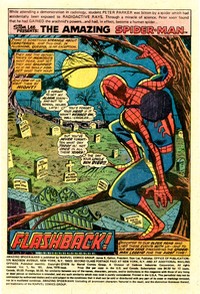 |
|
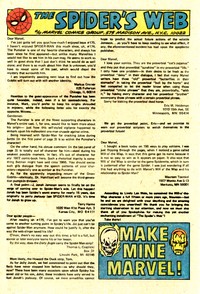 |
|
| |
| Later on, a
member of the cemetery staff happens to notice the
microscope and decides to take it home for his son. |
| |
| Preceding this
issue, Len Wein had just completed a lengthy run on Amazing
Spider-Man (#150-180), and before Marv Wolfman took
over the reigns for a run which would cover Amazing
Spider-Man #182-204, Wolfman in his role as editor
inserted a Bill Mantlo/Sal Buscema fill-in issue to
separate the two runs. The resulting Amazing Spider-Man
#181 is an almost plotless issue that simply recaps key
events and showcases Spider-Man's villains and supporting
characters. Dedicated "to our older fans who
lived these events with us -- and to our new fans
discovering the Spider-Man legend for the first
time!" this collage of Spidey's history is a
strangely fascinating reference book for newer fans (at
the time) and a nostalgic caleidoscope pastiche for the
more seasoned ones, referencing:
-
Amazing
Fantasy #15 (Spider-Man's origin)
-
Amazing
Spider-Man #1 (Spider-Man tries to join the
Fantastic Four)
-
Amazing
Spider-Man #2 (Peter Parker signs on with J.
Jonah Jameson's Daily Bugle)
-
Amazing
Spider-Man #5 (Flash Thompson kidnapped by
Dr. Doom)
-
Amazing
Spider-Man #6 (first appearance of the
Lizard)
-
Amazing
Spider-Man #7 and Amazing Spider-Man
#30 (beginning and end of Peter's relationship
with Betty Brant)
-
Amazing
Spider-Man #10 (first appearance of Fredrick
Foswell as Big Man, his death in Amazing
Spider-Man #52 and his daughter following in
her father's footsteps and her death in
Marvel Team-Up #40)
- Various
attacks on Spider-Man instigated by Jameson (the
Scorpion in Amazing Spider-Man #20, the
first Spider-Slayer in Amazing Spider-Man
#25, Luke Cage in Amazing Spider-Man
#123, the Fly in Amazing Spider-Man Annual
#10, and more Spider-Slayers in Amazing
Spider-Man #58, Amazing Spider-Man
#105, and Amazing Spider-Man #169)
-
Amazing
Spider-Man #90 (Captain Stacy's death)
-
Amazing
Spider-Man #100-102 (Michael Morbius turns
into Morbius the Living Vampire)
-
Amazing
Spider-Man #122 (Gwen Stacy's death)
-
Amazing
Spider-Man #124 (Colonel John Jameson
becomes the Man-Wolf)
-
Amazing
Spider-Man #136 (Harry Osborn became the
Green Goblin)
Given Spider-Man's
selling power it is no wonder that his titles (Amazing,
Spectacular and Marvel Team-Up) were
regularly featured in MARVEL MULTI-MAGS throughout the late 1970s
and very early 1980s (right up until the demise of
Marvel's polybagged three- and later two-packs), but this
issue is definitely different. While some may find it
boring due to the fact that there is actually no really
coherent story as such, I know that Amazing
Spider-Man #181 would have thrilled me to no end
back in the days, given the extensive rogue gallery it
features - and it still does. This is partly also due to
the fact that the
Sal Buscema and Mike Esposito
artwork does a good job of
presenting visuals which have a somewhat classic feel to
them.
|
| |
|
| |
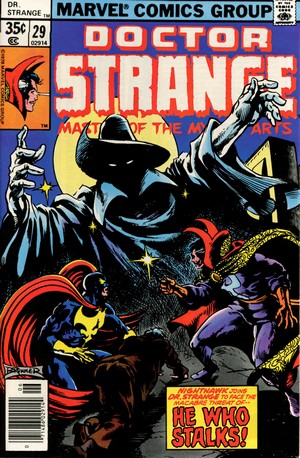
|
|
DOCTOR
STRANGE #29
June 1978
(bi-monthly)
On Sale:
14 March 1978
Editor -
Archie Goodwin
Cover - Frank Brunner
"He
Who Stalks!" (17 pages)
Story - Roger
Stern
Pencils - Tom Sutton
Inks - Ernie Chan
Lettering - Annette Kawiecki
Colouring - Petra Goldberg
Synopsis
!
SPOILER ALERT !
While
recuperating from his battle with
the In-Betweener
(Doctor
Strange #27-28), Dr.
Strange is called upon by
Yellowjacket who informs him that
the Black Knight statue has been
stolen from his Sanctum Sanctorum
and then destroyed. The Sorcerer
Supreme has, however, no time to
reflect on this as Nighthawk
approaches him for help in
solving a mysterious haunting
taking place at a Richmond
Enterprises research lab.
|
|
|
|
| |
| Doctor Strange and
Nighthawk soon discover that the reason for these
occurrences is the villain Death-Stalker, appearing on
Earth from the Limbo he is trapped in. His plan is to
steal a new prototype Proto-Converter being developed at
the lab and using this to free himself. In the ensuing
confrontation with Doctor Strange and Nighthawk,
Death-Stalker is defeated when a blast from the
Proto-Converter is redirected back at him through the
mystical Eye of Agamotto. |
| |
| The
available data on the contents of
MARVEL MULTI-MAGS
is somewhat sketchy, but in
the fold of 200+
known
Marvel comicpacks from 1973
to 1983 this
is only one of two occasions where a copy of Doctor
Strange was carried (the other one being the
previous issue, Doctor Strange #28, in
an April 1978 MARVEL MULTI-MAGS which also featured
Thor
#270 and Ms
Marvel #16).
Comic book
fans who depended on
MARVEL MULTI-MAGS
would therefore see very
little of and know even less about Doctor
Strange, the Sorcerer Supreme - such as the fact
that Doctor Strange #27 was only Roger
Stern's third issue of writing the good doctor.
His first run spanned Doctor Strange #27
(February 1978) to #37 (October 1979), but Stern
would later return for a longer (and acclaimed)
run starting with Doctor Strange #46
(April 1981) and ending with issue #75 (February
1986).
|
|
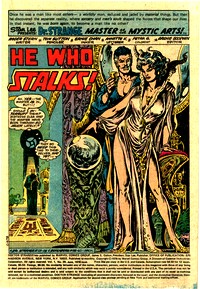 |
|
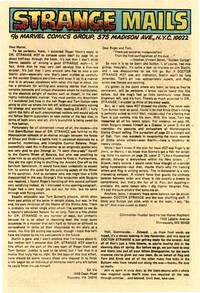 |
|
| |
| Stern's writing on Doctor
Strange (including Doctor Strange #29) has
often been praised as having been ahead of its time, and
his stories establish the sorcerer as often being called
upon by his peers from the superhero fold to help solve
problems which can't just be contained by physical powers
(as is the case in Doctor Strange #29). The
resulting stories make for some interesting reading with
a lot of "flow" to them. Tom Sutton's pencils
add a lot of atmosphere and a style all of his own,
harking back in some ways to the classic 1960s and early
1970s Doctor Strange artwork by Steve Ditko and Gene
Colan. Still, Doctor
Strange #29 remains something of an odd-ball in the
context of the late 1970s
MARVEL MULTI-MAGS, and it could well be that quite a
few buyers or recipients of this specific comicpack
didn't much care for Doctor Strange #29 at the
time.
If, however, you should be
interested in reading a bit about another example of
Roger Stern's run on Doctor Strange, you can do
so
here.
|
| |
|
| |
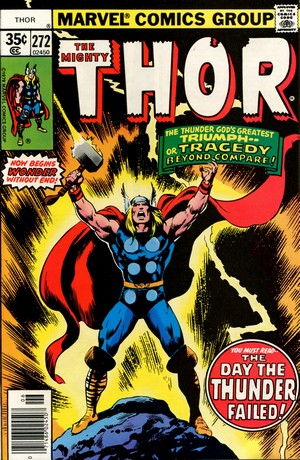
|
|
MIGHTY
THOR #272
June 1978
(monthly)
On Sale: 14 March 1978
Editor -Jim
Shooter, Len Wein
Cover - John Buscema
"The
Day The Thunder Failed!"
(17
pages)
Story - Roy
Thomas
Pencils - John Buscema
(breakdowns); Tom Palmer
(finished art)
Inks -
Tom Palmer
Lettering - Joe Rosen
Colouring - George Roussos
Synopsis
!
SPOILER ALERT !
Thor
tells a group of children about
his own youth and an occasion
when he and Loki were challenged
by Utgard, Master of Utgartdhall
in Jotunheim - the Land of the
Giants - to a series of contests
|
|
|
|
| |
| Loki
first faces Logi in an eating contest but stands
no chance as his opponent devours not only the
food but the plates and table as well. Next, Loki
is challenged to a footrace by Hugi, but loses
before he even makes his first step. Then Thor
accepts the challenge to empty a drinking horn
but finds that everytime he stops drinking the
horn is just as full as when he started. In the
next challenge, Thor is to lift a cat off the
ground but can barely get one of its paws up. In
the final challenge Thor has to best an old
woman, Elli, in a contest, but again fails
completely. It is at that point that
Utgard reveals to the two brothers that they have
been tricked by a spell of confusion: Logi is
really fire, Hugi is really thought, Elli is
really the personification of old age, and the
cat was in reality Jormungand, the Midgard
Serpent.
|
|
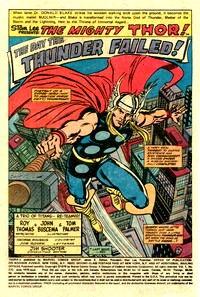 |
|
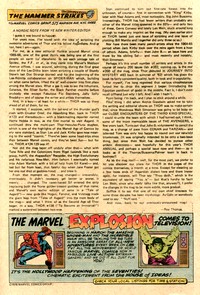 |
|
| |
| Thor #272 starts a
new run of Roy Thomas scripts and John Buscema artwork
(following the previous run by Len Wein and Walt
Simonson), and Thomas borrows from actual Norse lore for
a start: the contests faced by Thor and Loki are taken
from chapter 44 of the tale of Gylfaginning (which
is Old Norse for "The Deluding of Gylfi"), the
first part of Snorri Sturluson's 13th century Prose Edda (Lindow,
2002) - the original Norse version is summarized on a
Wikipedia page. |
| |

|
|
It is certainly a
nice touch and corroborates the
enthusiasm which Roy Thomas conveys on
the letters page (which he uses to pen a "Nordic
note from ye new writer/editor")
for Marvel's Thor.
Thomas of
course had a lot of clout with readers,
who knew that they could expect solid if
not excellent work, and Marvel certainly
had a field day with it: while in-house
ads proclaimed the Thomas/Buscema team-up
as a promise for "A New World of
Asgardian Enchantment!", the
cover blurbs on Thor #272
went even further:
|
|
|
| |
| "Now Begins Wonder
without End!" and "The Thunder God's
Greatest Triumph -- or Tragedy Beyond Compare!"
left only one conclusion: "You Must Read -- The
Day The Thunder Failed!". It was Stan Lee's hyperbole times two, but
as Roy Thomas said at the end of his note to readers: "As
Odin or somebody used to say: 'Nuff Said!" -
there simply was no way of arguing with it.
Issues of Thor appeared in
MARVEL MULTI-MAGS often and regularly, and Thor
#272 is definitely a gem. The adaptation of an actual
slice of Norse mythology is handled really well by
Thomas, and Buscmea's artwork really lets it fly. On the
whole, this issue is something of a throwback to earlier
issues of Journey Into Mystery and Thor (which
Roy Thomas also refers to in his "Nordic
note"), when Thor was less of a composed and
noble but rather a blustery and self-centered Thunder God
who required humbling every now and then - which, of
course, is what the contest at Jotunheim is all about.
The John Buscema cover of
this issue, by the way, has such a classic look and feel
about it that it is hardly surprising that it can be seen
quite often on posters, t-shirts and other items.
|
| |
|
| |
| No 1970's Marvel comic book
was, of course, without third party advertising, some of
which was "okay" (mostly if it featured Marvel
characters) and some of which was, well, something else
(such as the infamous flea market ads promising anything
and everything). |
| |

|
|
The
three titles included in this June 1978
Multi-Mag carried different ads,
illustrated here, and it is interesting
to note that by 1978 more and more
outlets selling comic book back issues
advertised in these pages (as well as an
increasing number of Star Wars
related merchandise). Interestingly
enough, the Hostess Twinkies ad featuring
Thor appeared in both Amazing
Spider-Man and Doctor Strange,
but not in Thor (where an ad for
Hostess Fruit Pies featured the Hulk). The Bullpen Bulletin
page also featured a plug for the 1978
live-action TV shows featuring Spider-Man
and the Hulk. Who could have imagined
back then that one day they would even
rule the silver screen...

|
|
|
| |
|
| |
|
| |
|
BIBLIOGRAPHY
LINDOW
John (2002) Norse Mythology: A Guide
to Gods, Heroes, Rituals and Beliefs, Oxford
University Press
|
|
| |
|
| |
|
| |
|
|


























